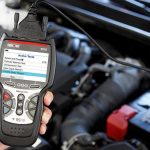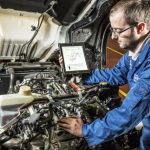If you own a car, then it’s important that you understand the basics of how it works and that you can deal with most problems that arise.
In fact, we believe that everyone should have a very comprehensive knowledge of their vehicles. After all, when you get inside a car you are essentially putting your safety at risk – so knowing how to operate your vehicle and how to solve issues that arise just makes sense.
What’s more, is that being able to fix issues with your car makes you that much more independent and self-reliant. It’s highly rewarding being able to make changes to your vehicle and if you can do this, then you’ll also save a ton of money by not taking your vehicle into the garage every few months…
But what if you’re not someone who knows a lot about cars? What if you’re someone who doesn’t know what a gasket is or how to top up their own oil?
Read on and we’ll look at the basics of how you go about diagnosing your car’s problems. Likewise, we’ll see how you can use more advanced equipment like VCDS (VAG-COM Diagnostic System).
The Basics
The reason that a lot of people never try to repair their own vehicles is that they’re afraid too. They think that if they try and make repairs on their own, that they will somehow break their vehicle and cost themselves thousands of dollars, or that they’ll put their lives and those of their family at risk.
So the first thing we need to do is to get you out of that mindset. Just keep in mind that fixing your car is just like fixing anything else – it’s perfectly safe and there’s nothing to be scared of.
For starters, you’re not going to cost yourself a lot by doing damage. Cars are highly resilient vehicles that drive thousands of miles across bumpy terrain. You probably aren’t strong enough to cause any serious damage to their main components!
And as for safety, there’s also a very simple solution to that – which is simply to drive your car slowly around the block before you take it for a long drive. Only once you’re very sure everything is working fine do you then take it out!
Bear in mind we’re talking basic things here – like finding oil leaks or replacing your brake pads. You probably don’t want to try and replace the entire engine yourself – so knowing your limits is also a good tip.
Fixing Easy Problems
So how do you go about diagnosing and fixing an easy problem?
Simple – you take the same approach you probably do to your health or to your PC. Simply, that means that you look at the symptoms. What precisely is wrong with your car? Does it vibrate a lot? Does it fail to start?
Likewise, think about the specific details. When your car vibrates, it could be caused by anything from tight brake to busted shocks. You want to try and identify then whether the vibration is coming from the front or the back, which will tell you where you need to start looking. Likewise, if the car doesn’t start you need to ask whether it’s not starting at all or whether it’s just puttering out quickly.
Now just type said symptoms into Google. ‘Car vibrating a lot from front wheels when driving’ or ‘Car not starting. Lights coming on.’
When you do this, you’ll then find a ton of suggestions and by comparing the symptoms to the symptoms of your own car you can probably pinpoint the precise problem.
Now all you need to do is to look up a YouTube video to find out how to fix the problem. There are plenty of these and by watching someone go through the process in front of you, it’s very hard to get it wrong. Of course it pays to watch a couple of videos to make sure they’re saying the same thing…
Using VCDS
Better yet though, you can invest in VCDS and never have to worry about taking your car into a garage again!
What is VCDS? Simply put, it is a car diagnostics tool that is very similar to the kind used by professional mechanics. When you plug this into your car’s OBD-II connector port and run software on your computer, it will run diagnostics on your cars various components and then show you precisely what’s wrong with your vehicle and how to fix it.
Yes – it really is that easy. VCDS can report on over 17,000 types of issues and will talk you through the solution in an easy to follow manner. It’s exactly like having a mechanic talk you through the problem… except they don’t need to be there!
Once again, it’s then often just a matter of buying the relevant part (which will cost you less if you’re not going through a mechanic) and then making the small change yourself.
Repairing cars is a lot easier than most people think and it’s something that everyone should learn. The best way to get good at it? Simply to get trying. The more you attempt to fix your cars issues, the more confident you’ll become and the easier you’ll find it. Everyone starts somewhere, so don’t be nervous! Invest in a VCDS and start fixing your car’s issues yourself from now on.






